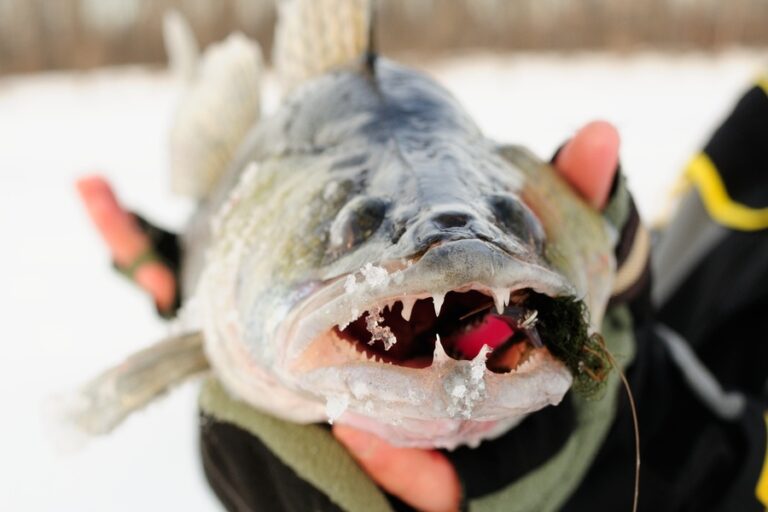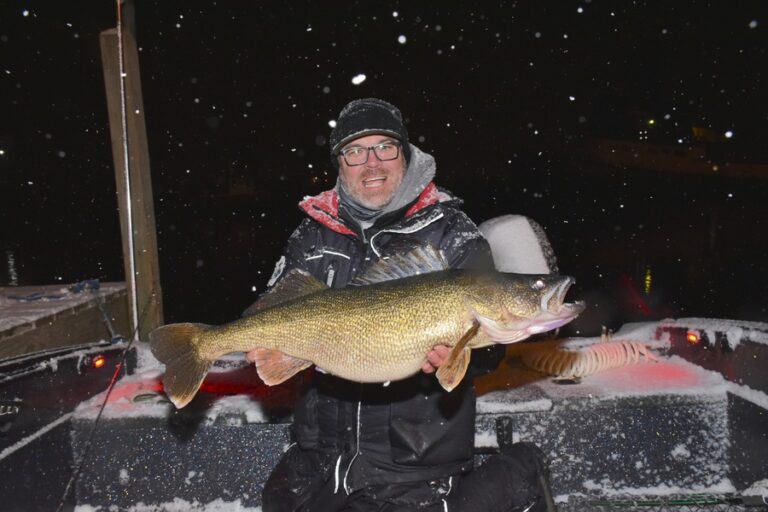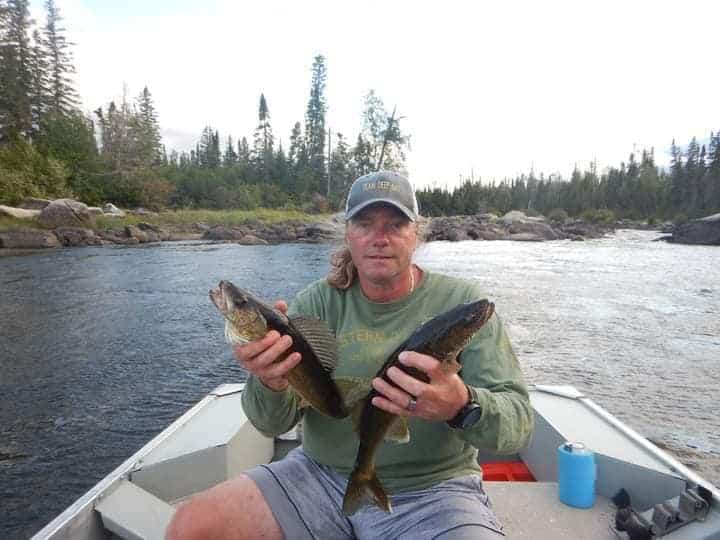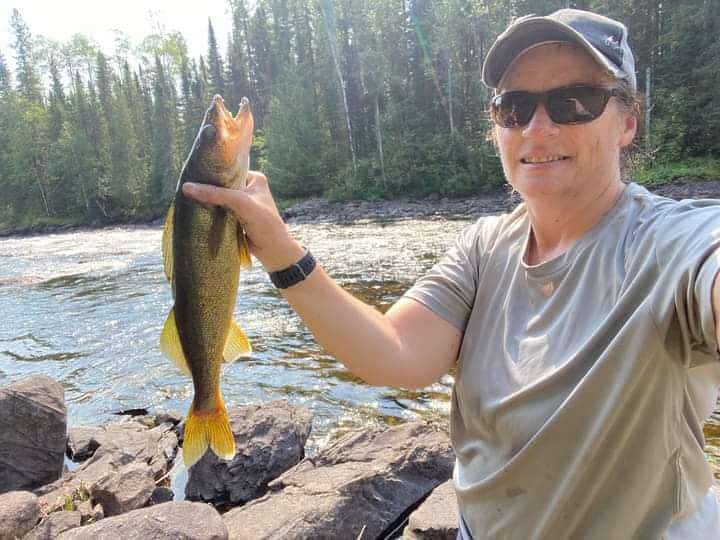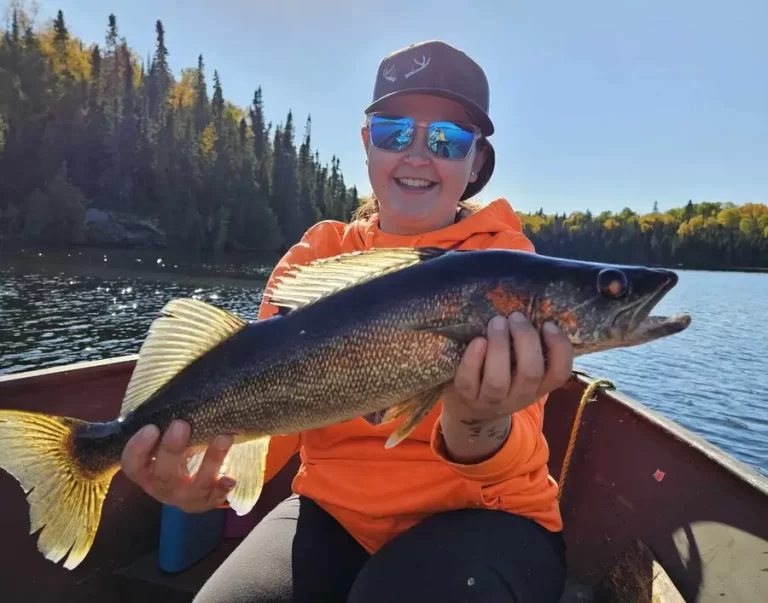Where to Catch Nighttime Walleye in Rivers: Complete Guide
Finding walleye at night on moving water like creeks and rivers can prove difficult. Knowing where to look at different times of the night will improve your catch rates.
At night, walleye in rivers often move to shallow areas near rocky points and sandbars to hunt in water 8-15 feet deep. Look for them near current breaks, where the water slows down, as they wait for food.

Table of Contents
Where to Catch Nighttime Walleye in Rivers
Sunset
Around sunset, walleye will move to shallow rocky areas and weed edges within casting range of riverbanks. Fish in water depths of 5-15 feet depth.
Focus on seams where faster and slower waters merge with walleye in the slower water. Fishing can be very good around sunset in rivers. It is my favorite time of the day to fish for walleyes in rivers and creeks.
Dusk
In the hour or so after sunset walleye will be found in transition areas like sandbars and the merger of shallower and deep water near dropoffs. Seams over 5-15 feet are the best. Fishing can be excellent this time of night in rivers and is arguably the best time of day to catch walleye.
Midnight
Fishing will slow down considerably as midnight nears. But fishing can be successful. Focus on 10-20 feet deep water in eddies or calmer pockets, looking for deep pools or mid-river humps.
Early Morning
In the early morning from about 1 am until around 4 am, focus on 5-20 feet of water along river bends and rocky outcroppings. Dropoffs can be great, too. Eddies behind rocks and seams can be the best locations. Fishing will be improving with the peak coming near dawn.
Dawn
Dawn is one of the best times to fish in rivers for walleyes. Look for submerged logs, rocks, and deep edges of weeds in 4-15 feet of water close to seams or eddies. These will be the best locations for walleye fishing.
Sunrise
Sunrise is a great time to catch river walleye. Look for walleye along the main current near the river bottom in 10-30 feet of water heading towards deeper areas. Drop-offs are a great spot to focus on.
Seasonal Nighttime Walleye Guide
Spring
In the spring, focus on eddies and river bends in water 5-15 feet of depth. In early spring, walleye will feed heavily, recovering from winter and prepping fat stores for the upcoming spawning season. Look for seams where faster-moving water meets slower waters.
Walleye will rest in the calmer water while watching for food in the faster current. The fishing can be excellent in spring, especially in early spring, before the spawn starts. The best time of day to catch walleye in early spring in rivers and creeks is from 2 hours before sunset until dusk.
Summer
Summertime walleye fishing can be quite good; however, the warmer water make walleye more lazy during the day. As a result, nighttime will be much better. The best times to fish for walleye in summer is at night as well as dawn and dusk.
To find walleye, walleye will be deeper during the day and shallower at night. Look for 15-30 feet deep during the day in deep holes near submerged structure. They will push shallower at night, following baitfish into cooler waters. Focus on deeper pools, rock pilings, and the edges of weeds if you can find them at night in the river.
Fall
Fall is one of my favorite seasons to fish for walleye in rivers at night. Walleye fishing can be really good from dusk until just before dawn in early fall when walleye are ramping up feeding to prepare for winter.
Look for sandy or gravel bottoms focusing on sandbars, drop-offs, and rock in 5-20 feet depth. Walleye will be close to the main current but rarely in it. Instead, they will rest in the seams in the slower current, watching the faster water.
Winter
River fishing at night in winter is tough. I probably would not recommend it. However, you can still catch some walleye. Focus on deeper holes in the 15-30 feet range in calmer water but away from any formed ice cover. From sunset until an hour after dusk will be your best bet.
For a complete breakdown of where to catch walleye, check out this guide. For a complete breakdown of where to catch walleye in rain, check out this guide.
Best Nighttime Walleye-Attracting Features
Deep Pools
Deeper pools in 10-30 feet of water are awesome walleye spots year-round but especially in summer and winter when the most comfortable water is found down deep. Midnight until dawn is the best time to find walleye here. Focus on the seams and eddies of deep pools over muddy or gravel bottoms.
Rocky Outcrops
Another great walleye spot at night is over rocky outcrops. These deep rocks over 10-20 feet of water attract a ton of baitfish and hold plenty of crayfish for walleye to feed on. Fish at the base of the rocks where the sand or gravel begins.
These locations will hold walleye and other fish all night long. The best season to fish rocky outcrops is during the summer at night.
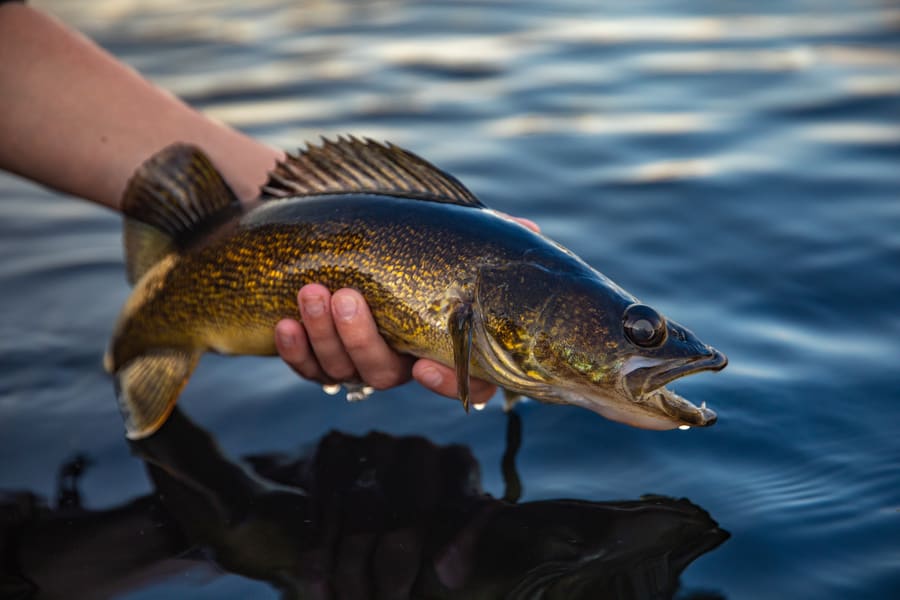
Eddies (circular currents)
Eddies are fantastic nighttime walleye spots, especially in spring when the rivers flow fast. Walleye will pour into these slack zones behind rocks to escape the current and find clearer water. Eddies provide calmer water and funnel food from the stronger currents.
You can find walleye from 5 feet below the surface to 20 feet. Sunset until midnight is the best time to fish here.
River Bends
River bends are one of my favorite wintertime spots on a river, especially at night. The slow-flowing water inside the bend is where you’ll find walleye resting while the faster water outside the river bend will funnel bait downstream.
These bends offer slack water near faster water for walleye to rest and feed. Focus on water 10-25 feet deep over sand or mud for the best results. Midnight until sunrise is the best nighttime time to fish here.
Weed Edges
The deeper edges of weed beds and cabbage can be a great nighttime spot for summer walleye in rivers. Fish will congregate here from sunset until dawn. Late spring through mid-summer is the best time when weeds are at their peak.
Fish over water 3-15 feet of depth ontop of muddy or sandy bottoms with rock. All moon phases can be good but full moons are my favorite moon phase for river walleye.
Sandbars & Drop-offs
Sandbars and drop-offs are very good nighttime features for river walleye. They attract a ton of baitfish and are great ambsh sites.
Look for drop-offs in 5-30 feet above a transition of sand to deeper silt or clay bottoms. Quarter moons in summer is the best time to fish here. Walleye will most likely congregate here from dusk until around midnight.
Pro Tips: Locating River Walleyes at Night
- Deep Pools: Walleye often retreat to deeper river sections at night for safety and to find prey.
- Rocky Areas: Cast near rocky or bouldery sections. Walleye use these areas as hiding spots and to hunt smaller fish.
- River Bends: The inside bends of rivers usually have slower water. Walleye like to rest in these calmer waters.
- Confluences: Places where smaller streams or creeks join the main river can be hotspots. The meeting waters bring in food, attracting walleye.
- Sandbars and Drop-offs: These are transition areas where shallow water becomes deep. Walleye patrol these zones looking for food.
- Near Submerged Objects: Logs, large rocks, or any submerged structures provide shelter and hunting grounds for walleye.
- Slower Currents: Behind large rocks or other structures, the water slows down. Walleye like these slower spots.
- Weed Edges: If there are patches of weeds in the river, the edges can be prime locations. Walleye lurk here to ambush prey.
- Moonlight Reflection: On clear nights, observe where moonlight reflects on the water. These lit areas can attract baitfish, and in turn, walleye.
- Tailwaters: Areas downstream from dams or other barriers often have a mix of currents and food, attracting walleye.
- Eddies: These are circular currents in water, usually formed on an obstacle like a rock. Walleye often rest in eddies.
- Water Temperature: Walleye are sensitive to temperature. On some nights, they might prefer warmer or cooler patches of the river.
- Shoreline Shadows: The shadows along the riverbanks, especially near overhanging trees or cliffs, can be hiding places.
- River Width: In wider river sections, walleye often move closer to the banks for food.
- Migratory Paths: During certain times of the year, walleye migrate. Learning these paths can help pinpoint their locations.
- Rippled Surfaces: On windy nights, areas with slight ripples (but not heavy waves) can attract walleye as they break the moonlight, providing cover.
- Listening: Sometimes, you can hear baitfish activity on the water’s surface. Where there’s prey, predators like walleye aren’t far.
- Tributary Mouths: The mouths of small tributaries can bring in food and oxygenated water, making them attractive to walleye.
- Depth Finders: Use electronic depth finders to locate deep pockets or underwater structures where walleye might congregate.
- Local Knowledge: Sometimes, the best way to locate walleye is to ask local anglers. They often know the river’s best-kept secrets.
Frequently Asked Questions (FAQs)
Do walleye stay shallow or deep in rivers at night?
At night, walleye usually come to shallow parts of the river to find food. They leave the deeper areas to hunt closer to the river’s surface.
How does river current affect walleye positioning at night?
Walleye use the river current to their advantage at night. They often stay in places where the water slows down, making it easier for them to catch their food as it drifts by.
Why are walleye more active at night in rivers?
Walleye are more active at night because it’s cooler and darker. This makes it easier for them to surprise and catch their prey.
How does moonlight affect nighttime walleye fishing?
Moonlight can help walleye see better at night, which makes them hunt more. For anglers, a brighter moon can mean more chances to catch active walleye.
Conclusion
Weather plays a big role in walleye fishing, both day and night. At night, walleye often swim to shallow spots near rocky areas and sandbars in rivers. Right around sunset, they prefer water that’s 5-15 feet deep, close to riverbanks.
As night progresses, they move to places where shallow and deep water meet, especially near drop-offs. By midnight, they like deeper spots, around 10-20 feet. Early mornings are also a prime time, especially near bends and rocks.
Dawn is a special time, as walleye gather near submerged objects in water 4-15 feet deep. By sunrise, they start heading deeper, close to the river’s bottom.

